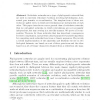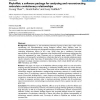148 search results - page 1 / 30 » Reconstruction of Reticulate Networks from Gene Trees |
RECOMB
2005
Springer
14 years 5 months ago
2005
Springer
Abstract. One of the simplest evolutionary models has molecular sequences evolving from a common ancestor down a bifurcating phylogenetic tree, experiencing point-mutations along t...
RECOMB
2004
Springer
14 years 5 months ago
2004
Springer
We present new methods for reconstructing reticulate evolution of species due to events such as horizontal transfer or hybrid speciation; both methods are based upon extensions of...
RECOMB
2007
Springer
14 years 5 months ago
2007
Springer
Reticulate networks are a type of phylogenetic network that are used to represent reticulate evolution involving hybridization, horizontal gene transfer or recombination. The simpl...
BMCBI
2008
13 years 5 months ago
2008
Background: Phylogenies, i.e., the evolutionary histories of groups of taxa, play a major role in representing the interrelationships among biological entities. Many software tool...
BIOINFORMATICS
2010
13 years 5 months ago
2010
Phylogenetic trees are widely used to display estimates of how groups of species evolved. Each phylogenetic tree can be seen as a collection of clusters, subgroups of the species ...


